Saturday, March 31st, 2018
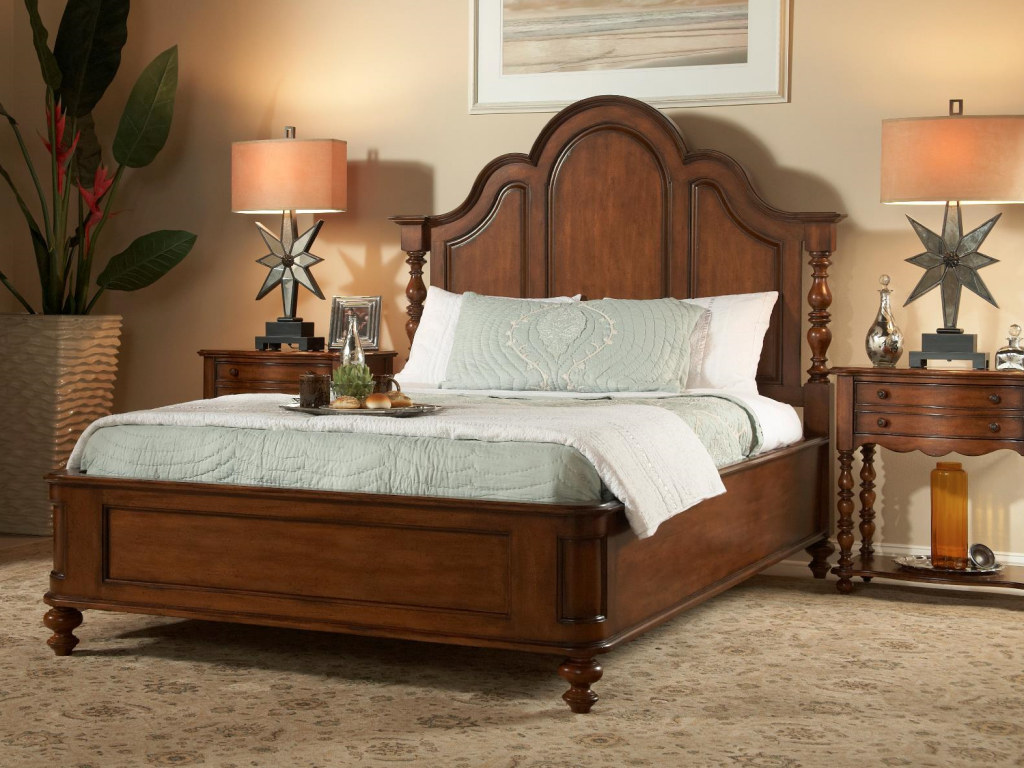
Where do your eyes automatically go to? Naturally, Summer Home Collection’s Platform King Bed is an effortless star.
Any room’s focal point is the most important element in that space. Simply put, it is no less than the star of the show. This is the very spot where the viewers’ eyes would go to the moment they enter the room. Since this is so, you have to learn to recognize, pick, and use a focal point to your advantage.
Recognize the Focal Point
Pinpointing the architectural element or furniture that’s the room’s focal point isn’t easy. Sometimes, it’s easy to spot it because it is an obvious featured part of the room. More often than not, though, you could actually stage something to become the focal point.
So let us begin with the obvious focal points –
Fireplaces. This is the very anchor of a bedroom, living room or dining room. The key to making the most of this focal point is to arrange the seating units all around this architectural feature. As much as you can, hang a bold art piece right above the mantel.
Vaulted ceiling. This is one architectural part of the home that does not beg for extra design. Even so, you still have to make sure that it is always freshly-painted and, yes, cobweb-free. If you want to ascertain that the vaulted ceiling won’t be missed, then hang a lovely lighting fixture for everyone to appreciate. This can be a crystal chandelier or a unique pendant light.
Windows and picturesque views. If your home happens to be blessed with eye-catching views, then you won’t have to put much effort in highlighting those focal points. Again, since these are naturally beautiful views, eyes will naturally travel there. Make sure that the windows are unobscured so that everyone gets to see the lovely scenery outdoors.
Angled walls. You can make one of these as a focal point if you create an accent wall. There are many ways to achieve this type of wall. You can go dark and be dramatic or you can offset the neutral colors of the other three walls with a bold, vibrant hue. After all, who wouldn’t want to look at an orange wall?
Another way to create a focal wall is to use wallpaper. Find a pattern or design that coincides with the rest of your home’s theme while being able to stand out from the other walls.
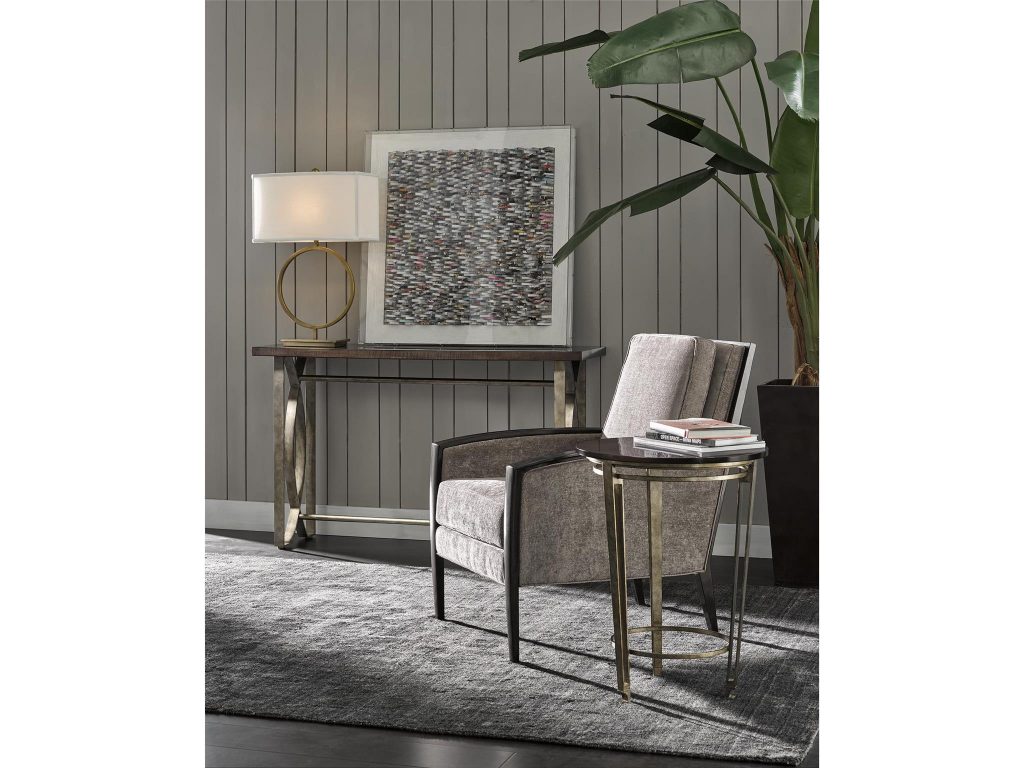
What about here? The Console Estrelas from Fine Furniture Design (Deco) houses the focal point which is this interesting work of art.
Choose Works of Art
Other than architectural parts of your home, you can bring in some works of art that are big enough to be referred to as a statement. This statement art can be replaced by a mirror but rather than go for the traditional or default mirror, why not hype things up a bit and place something that will excite the viewers’ senses?
In determining which artwork to use, you might want to go outside of the usual painting. While big, bold paintings are wonderful focal pieces, they are far too common. This time, find a lovely bust that you can display and highlight.
Buy Unique Furniture and Learn Furniture Placement
While you are advised that your furniture choices should primarily be practical, this does not mean that you can no longer create a sense of excitement with your choices. A unique piece that has a bold pattern, fabric, or shape can readily steal the spotlight from other design elements in the room.
The natural focal pieces include the sectional, a large couch, the bed, the dining table, and the china cabinet. Be sure to use placement techniques that work. For instance, if you want to highlight a decorative lamp, then be sure to place it right at the very front and center of a console table.
Tags: focal point, focal point recognition, focal points, McCreerys, McCreerys Home Furnishings, recognizing a focal point
Posted in Architectural Elements, Furniture, Interior Design 101, Interior Design Elements | Comments Off on How to Make Focal Points Work
Friday, March 30th, 2018
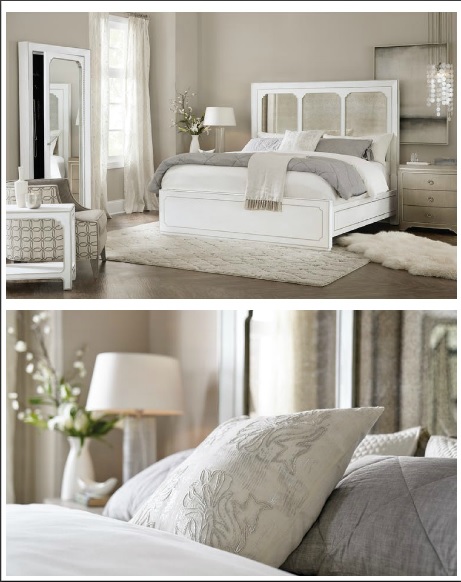
Coming Soon: Hooker Furniture Bedroom Modern Romance King Panel Bed for your shabby chic bedroom.
Shabby chic – should you consider using this as the theme for your home – is bright, light, pretty, and classic. This style has become quite popular but the hub of its many admirers are in England and France. The year 2012 has been a great year for this design and just like the vintage design, it is a style that conveys comfort and a certain level of femininity. Their only difference?
Shabby chic presents a used or worn look. You could somehow look back to those days when you visited your grandma’s home ‘cept that the shabby chic is now more appealing and stylish.
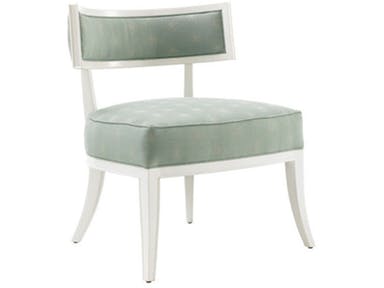
The Lexington Living Room Byblos Chair 1530-11 is just right for a shabby chic living room.
Key Shabby Chic Elements
Designing with shabby chic means you are ready to embrace part-ashen wood furnishings. The style is often vintage with white or cream as the main color palette. You could almost feel nostalgic with this style just as it initiates romantic feelings in most beholders.
Since white is the chief color, you should not be bound to just one tint. You can use different tints or shades depending on your taste. In doing so, you set up separate or distinct spaces in your living area.
Other colors that you can use with the shabby chic style are beryl green, bluish gray, powder blue, baby pink, the color of Azalea, marzipan, and wool white.
You will need to widen your imagination since you’re making new furniture look old. If you’re uncertain about how to update your furniture to the new shabby chic look, then you can choose from our lovely pieces – here.
European cottage, offered mostly by Stanley Furniture which we also carry, offers a wide variety of shabby chic pieces, too – choose from our European Cottage pieces.
You can opt for skirted chairs and couches.
When it comes to the accessories, go all out. There are no limits with regard to this decorative element. Look for opulent porcelain sets, rose-flowered curtains and cushions, and vintage-looking picture frames.
Never be afraid to mix and match with the shabby chic style. Don’t be limited to just white or cream. You can have different finishes and colors coming from different eras. You can either stain, paint, or distress your furniture.
Shabby chic is also about being sophisticated while being sunny. It is the proper mixture of bold, vibrant pieces with the more subdued and classic ones. Again, do not forget that this style is basically feminine so go ahead and install that curvy mirror with gold framing. You can also hang that glittery chandelier to make your feminine statement complete.
If you love the look of contemporary interiors but still like to use shabby chic as your theme, well, don’t fret. To achieve a contemporary edge, try to use clean-lined furniture pieces instead of the ornate ones. Make sure that the architectural features also do not have any ornate designs.
It could get a little fuzzy when you realize that your shabby chic living room is starting to look like Nordic interiors. To soften the look and make it appear warmer and more welcoming, use natural warm woods, slip-covered furniture pieces, and vintage leather. The idea is to use these charming pieces to offset the mainly white surroundings.
Next, make the patinas work. Well-worn furnishings are the best pieces to create a more comfortable and intimate feeling in a space. Use an old door as a headboard. Remove loose paint using steel wool (the fine type) and cover with a protective sealer.
You can also go eclectic with shabby chic. If you happen to have a large collection of chinaware, then show them off in your shabby chic dining room and kitchen. A white, distressed china cabinet would do well to display your prized collections.
Tags: designing with shabby chic, McCreerys, McCreerys Home Furnishings, shabby chic, shabby chic design, shabby chic design elements, shabby chic style
Posted in Color Schemes, Interior Design 101, Interior Design Elements, Interior Design Themes | Comments Off on Shabby Chic: A Fashionista’s Haven
Thursday, March 29th, 2018
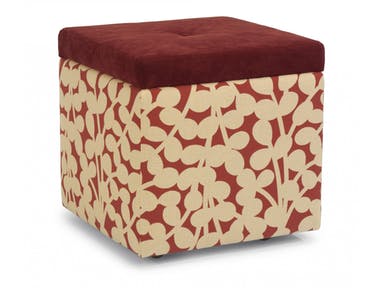
Double-duty furniture: Flexsteel Living Room Fabric And Kashmira Storage Ottoman
If you’re a parent who’s thinking of setting up a room for your little one, then you might be at a point when you no longer know how to have him (or her) onboard on the project. After all, a kid could default to his favorite cartoon character or would wish for a unicorn-filled bedroom. If none of these designs would make sense with your overall theme, then it’s time to learn a few techniques.
Consider Your Kid’s Happiness
When it comes to a kid’s room, remember that you need to consider his freedom, his sense of creativity, his boundless energy, and of course, his happiness. Think of his room as his personal sanctuary, a playground where no one would judge him.
While kids’ safety matters, this does not go to say that they will see the CCTV cameras and whatnot. Learn to install security features in the room that would not hamper with the fun that is also supposed to happen there.
Make Room for Adjustments
Kids are known for their fickle-mindedness as they alter their tastes from one cartoon character to a sports team, and on. If you want a room that will grow with your kid along with his design preferences, then you might want to invest in the more classic furniture designs.
So, rather than buying a kid-sized drawer, pick one that can store more clothing in the future. If your space allows it, then invest in a bigger bed from the outset unless, of course, when you’re setting up a nursery in which case, you have to pick furnishings that are infant-appropriate.
Buy Double-duty Furniture
A multifunctional furniture is the most ideal piece to put in your kid’s room. This is especially when you’re looking to change a nursery to a bigger child. And when it is finally time to replace the crib with a bed, then make sure that you get the one that has storage underneath. This simple storage solution should help keep your kid’s room tidy.
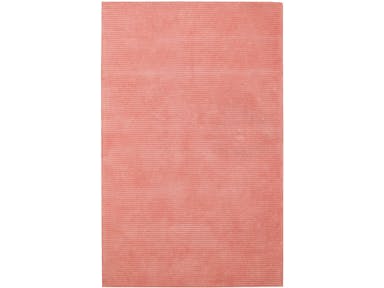
While parents are cautioned against being ‘boxed in’ on some gender-assigned colors, pink is just so deliciously lovely that it’s difficult to not use on a girl’s bedroom floor.
Use Fun Colors
While you are encouraged to set up a room that your kid could grow into, you might also want to consider that you’re decorating the room for a kid. And a kid will always be a kid so if you are left to pick the colors, then add the fun hues.
Neutrals can be used but be sure to offset the boring look with bold accents. And if the rest of the room is bold-colored, then pick tamed furnishings.
Choose Kiddie Themes
There are many kiddie themes to choose from online. Take the time to scour these options with your little one. Make him point to the ones that he likes and take note of those. Neutral themes include zoo trip, Toy Story, basic pastels, Old Western, farm animals, etc.
For boys’ bedroom themes, you can choose from Captain America (and any other superhero), shark theme, Star Wars, etc. As for girls, the options could include Disney princesses, rainbows, the traditional pink, and playland.
Ask Your Kid for Suggestions
Learn to think outside of the box. To do this, ask your kid for suggestions. You will be surprised at the plethora of ideas that could flow out of his young mind.
If you have, say, a five-year-old who is adamant in picking the paint color for the walls of his room, then don’t hamper that creativity. Give him some control but learn to coax if the colors start to clash. You have to learn to walk the line where you’re guiding the choices that your little one makes while he still has the leeway to suggest what he truly desires.
For starters, you can narrow his paint color options to just five so he can point to the one that makes sense to him the most. You could also do the same thing with the color of the furnishings. Having the kid onboard in this whole project will increase his self-esteem and even his love and respect for you.
Tags: designing a kid's room, how to design a kid's room, kid's bedroom, kids' play room, kids' room, McCreerys, McCreerys Home Furnishings
Posted in Bedroom Design, Interior Design 101, Interior Design Themes | Comments Off on How to Setup Up the Kid-approved Room
Wednesday, March 28th, 2018
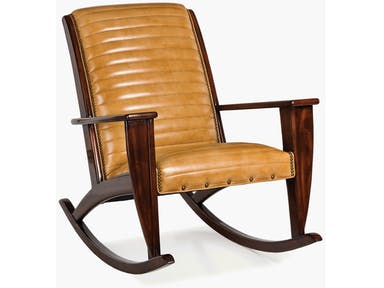
Hancock and Moore Living Room Adirondack Quilted Rocker 5844-R-Q: Have this lovely piece welcome your guests to your home.
Do you know the famous Shakespearean quote, all the world is a stage? He might have not thought of the world of interior design to make sense of this very thought when he was saying it but, here we are, in a world where homes are staged.
Home Staging History
Many of you might not think how home staging all began when you’re out buying your next home. This all started in 1985 when Barb Schwarz created the concept of staging. She believed that a home staging investment is less costly than the reduction in the value of a home if it is not presented to the market appropriately.
Indeed, statistics have proven that staged homes sell more than the un-staged ones. Also, staged homes tend to stay 80% less time on the market.
What Is Staging?
Staging is an art. This is the art of setting up a home so that it will look its best. Of course, the homeowner remains the owner of his property up until the time when he finally decides to let go of it. Once this happens, the property becomes a marketable product, and just like any product, its features and benefits must be highlighted.
You have to stage a home like a buyer is going to purchase a dream.
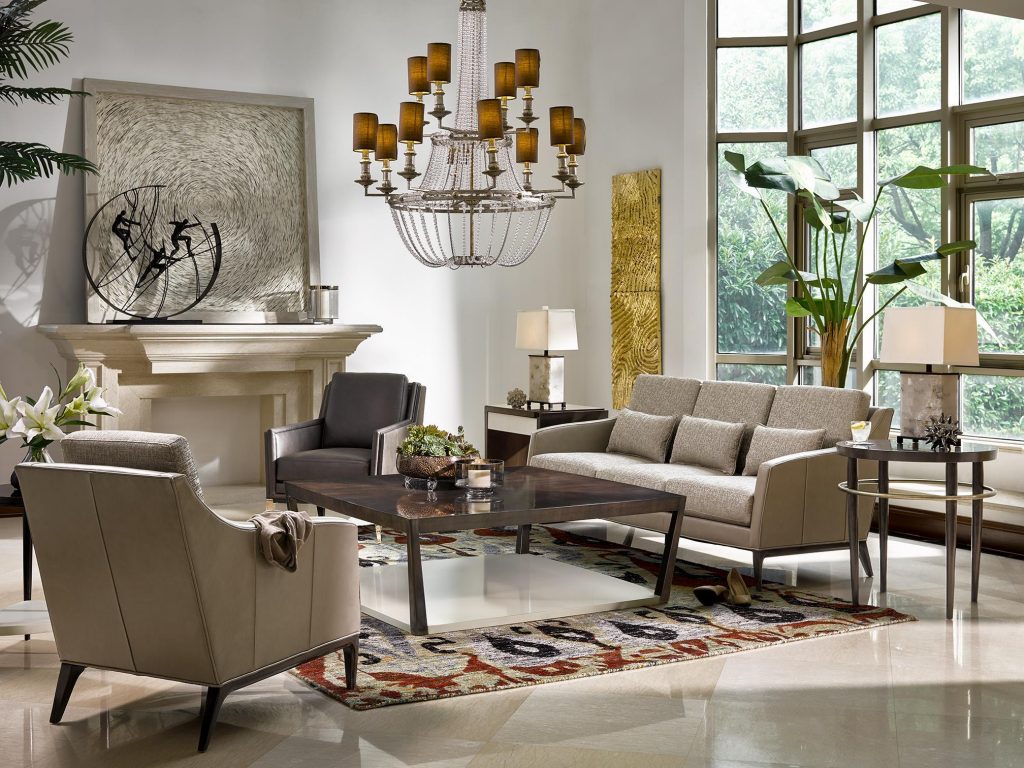
Astonish your family and guests with the Fine Furniture Design’s Deco Collection for the living room.
Home Staging Tips to Steal
Mind the curb appeal. This is number one because this is the first impression that the home is going to give. Invest in flowering plants and some Adirondack chairs to spice up the welcoming ambiance. Cut any overgrown weed and add plantings to up the stylish appeal of your front yard.
Remember that staging does not begin in the interiors of a home and neither does interior design for your own benefit.
Install ample storage. Just as you would pack your personal belongings if you were staging a home, you also need to make sure that your guests will not see any clutter that does not make sense. Keep the toiletries right where they should be and the children’s toys in their respective boxes. It’s all about finding a space for each of these things when they are not in use.
Do decorate with framed family photos, though, as this will personalize your home.
Define the room functions. Be sure to arrange the rooms the way that they are supposed to be utilized. If the architecture all highlight that lovely fireplace and the room is obviously a living room, then use it as it was intended to be.
Your chosen furnishings will also play an important role in making your home aesthetically enviable. Just as home stagers give buyers a sense of how each room is supposed to be used, then your goal as a homeowner who is expecting to bring family and friends in is to fill the spaces with relevant furniture pieces and their corresponding accessories.
Designate kids’ and pet’s areas. This does not mean that your kids or your fur baby won’t be welcome in your home. It is all a matter of giving them their own spot, too. Home stagers know how to organize a home where there won’t be runaway toys to worry about.
Doing this will also teach your kids discipline as they learn to put their own stuff in their own space. As for the pet, be sure to delegate a spot as well where its calls of nature won’t become the center of attention.
Always ask for a second opinion. Don’t ask a friend or a relative for their second opinion because they might end up being nice to you. Have a third party who will critically look all over your home. Hearken to the reviews of this person especially if this person is an expert on interior design.
Tags: home staging guidelines, home staging tips, McCreerys, McCreerys Home Furnishings, staging your home
Posted in Interior Design 101 | Comments Off on Home Stagers’ Secrets to Copy in Stylizing Your Home
Friday, March 23rd, 2018
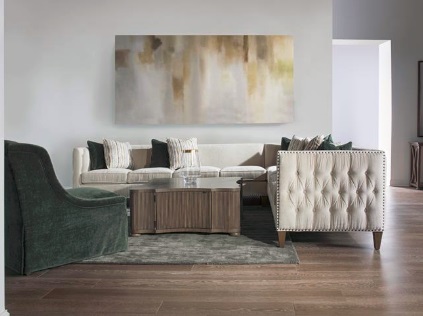
Fine Furniture Design’s Cachet Collection: Notice the three seats in this living room. Two of them come in the same neutral hues while the third one, the couch on the left comes in a darker color.
Did you notice how interior design trends get hotter and more chic each year? With more and more interesting design elements being added to the fundamentals, sometimes one would think what happened to the basics? Is there something wrong with just relying on the basics or do these elements still work? Today, let’s look at informal balance also known as asymmetry.
Why Does Asymmetry Matter?
Asymmetry, simply put, is a kind of balance. Generally, as homeowners and designers think of balance as a design concept, they just stick with symmetry or perfect balance. This is like making use of mirror images in your home. This is, of course, always a wonderful option, in fact, you could never go wrong with it but if you want to stand out, this may not always be the one that would take you to that road to uniqueness.
If symmetry is all about creating a mirror image and making it balance the other half of the space, then asymmetry is all about the repetition of other elements such as colors, forms, and lines. You won’t see any splitting-into-halves with the second type. This is like setting up a living room with a feature couch and an end table plus a floor lamp.
Informal Balance Equals Visual Interest
Now that both types of balance have been defined, it’s time to take a closer look at informal balance. Asymmetry is commonly used because it adds visual interest. After all, compared to symmetrical designs, it is not common. Repetition does tend to look monotonous over time so having achieved an asymmetrical look adds to the enigma of a space.
There is a psychological aspect to asymmetry. Our brains normally process information that is repetitive or are in pattern. The mirroring effect in symmetrical homes makes it a lot easier for humans to figure out what the function and style of a room are.
If, however, the design is asymmetrical, it can take minutes for the brain to absorb what is really being depicted. The design is not obvious so the brain works harder in figuring out what is being shown to it. Since the brain tends to work hard with this kind of balance, it defines the space to be more interesting.
An asymmetrical element can also be found in a symmetrical surrounding. An example of this is the fireplace that’s right in the middle of a living room with the same number of chairs and a monochromatic color palette. But notice where your eye goes to the moment you enter the room.
There’s your answer.
Informal Balance Is More Casual
You have probably seen hundreds of mirror image designs in your entire life. It is likely that the stately dining rooms that you’ve seen online or in magazines show long dining tables with two rows of chairs that all look alike. The rigidity of the duplication in such a style is symmetrical and, therefore, more formal.
In contrast, the asymmetrical style isn’t absolute. It does not try hard to be perfect. In fact, there is a huge allowance in the differences in each furniture piece’s arrangement. This is what makes the space appear more casual. The so-called lived-in appeal is apparent in every asymmetrically-designed space.
Mastering Informal Balance
The last step is to learn how to pull off this kind of design. There aren’t any hard-and-fast rules but there are a few tips that most designers agree with.
Tags: asymmetry, informal balance, McCreerys, McCreerys Home Furnishings
Posted in Interior Design 101, Interior Design Elements, Interior Design Themes | Comments Off on Making Informal Balance (Asymmetry) Work
Thursday, March 22nd, 2018
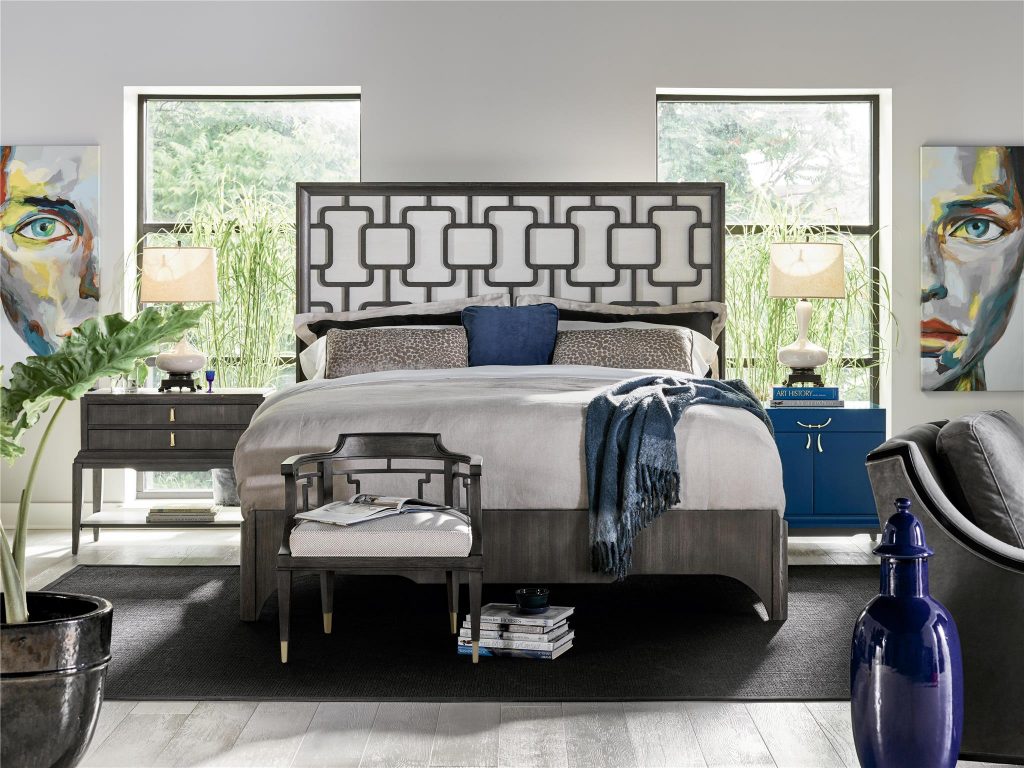
Panache Panel King Bed from the Fusion Collection of Fine Furniture Design. Define how the 80/20 rule is followed in this room – the main furniture pieces comprise the 80% while the accents and accessories, all colorful and bold, comprise 20% of the space.
Have you ever come to a point, when designing your home, that your style is too broad to be defined by just one theme? Sometimes, you might even think that you’re the only one with such sense of style. Don’t fret, the fusion of two design themes is a common practice in the world of interior design. Combining style, however, requires the most skilled hands so you won’t turn elegance into a garish display of mismatched elements.
When fusing more than one design, always remember that your preference matters. While this is so, don’t forget about these simple rules, too –
Function on a Pedestal
Always put function first so you won’t end up getting confused. There are even a few designers who think that when filling a space, they need to use the different design elements all at once. They end up with an overfilled or overstuffed space with an unclear style.
To veer away from this mistake, just consider function first. This means that you use functional pieces of furniture guide you in starting your design. While every space is in need of aesthetic touches, these should take the backseat where function is needed.
Ideally, the room’s purpose must be evident from the furnishings that one can see inside that space.
Learn and Apply the 80-20 Rule
Using two designs is all about making sure that both work together rather than against each other. Assign a definitive role for each style and then follow this as you continue designing the rest of the room.
The 80-20 rule means you have to allocate 80% of the design to the style that you would want to dominate. This is going to be your main focus and will be your chief influencer throughout the room. Always use the dominant style in deciding the main color palette, furniture, flooring, and lighting materials.
As for the remaining 20%, this must become the background. Its background role is to provide accent pieces that would go with your dominant design. Pick lighting fixtures based on this role, too. Choose eye-catching lighting pieces, wall art, and other accessories.
Infuse General Threads
Every space must include the elements that have general threads that join them. This is especially applicable when you’re trying to fuse two distinct styles that do not normally go together. You might want to pay attention to the common ground between these looks that you have chosen.
One of the successful hybrid interior designs is the so-called Japandi which is a mixture of Japanese and Scandinavian styles. What common elements could you see in both? One would picture wintry days as well as the simplicity of the furnishings.
No matter which styles you choose to combine, you will need to consider the colors that complement or contrast each other. It’s as basic as that. Tying the details altogether means knowing which colors can be mixed and which textures or patterns would go well together.
Learn to Highlight
As you create a hybrid style, you might end up with one piece that just simply doesn’t belong in the group. When you are faced with this dilemma, don’t resort to hiding that piece straightaway. Instead, let it stand out and be the central piece. Highlight this piece and have it become the focal point.
You may want to work on the angle that you place this furniture piece so that the eyes of your visitors will all be drawn to it. See also that the rest of the furniture pieces are angled towards it highlighting it all the more. If you’re highlighting a piece of art or mirror, then be sure to position it above a significant architectural feature such as a fireplace.
Tags: fusing two styles, McCreerys, McCreerys Home Furnishings, mixing designs, mixing interior designs, mixing style, two styles
Posted in Accents, Accessories, Furniture, Interior Design 101, Interior Design Elements, Interior Design Themes | Comments Off on Fusing Designs Minus the Confusion
Wednesday, March 21st, 2018
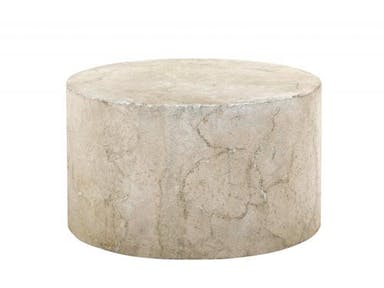
The Bernhardt Interiors Living Room Cocktail Table is concrete and is ‘texturally’ beautiful.
When you’re asked to consider concrete as a design element in a home, you might become hesitant because this is a material used on pavements and the very foundations of homes. However, more and more interior designers are looking to this material as an awesome way to beautify a home. It actually offers various stylish looks that stand out from the rest.
Sure, concrete could look a bit on the rough side but this ruggedness can also be subdued to appear warmer and even cozy. If you were to learn some guidelines in effectively using concrete as a design element, would you be willing to consider it for your home?
A Great Medium
Concrete can be a great medium especially when you live in a home that’s almost entirely made of wood. Adding concrete would offset the too organized or formal look that wood offers. When choosing concrete, make sure that you pick a supplier that will provide one with the best quality.
For this year, 2018, you might have noticed that the design trends aren’t exactly absolute. In fact, they tend to be polarized as the colors are bold although, aesthetically, the more neutral elements are also still utilized.
Such is the look that is being offered by concrete. It is subtle, it is not as jolting as this year’s Pantone Color of the Year but it is, nevertheless, a stylish element that can give any design element a good fight.
The Industrial Edge
Concrete is synonymous with the industrial interior design. No other element epitomizes the beauty of this style more than this material. Just imagine the old warehouses and industrial buildings from decades ago and you are already conjuring a picture of a concrete-themed home.
Other elements that make the industrial design unique are the reclaimed types of machinery as well as other metallic accent pieces. Add an exposed steel or wooden beam here and there and you’ve just created the basic look for an industrial home.
If you want to know where to begin with the industrial look, then go for concrete floors. These are the natural choice more particularly for homes with rustic exposed wood.

Here, the concrete floor is made cozier by the placement of an area rug. Featured here is the Brentwood Collection from Fine Furniture Design.
Concrete Is Texture
Visual and tactile texture can add amazing amounts of interest into any space. Talking on the level of an interior designer, texture is an element that allows you to feel even when you’re just looking. While you do know the feeling of running your hands over rough or smooth concrete, looking at it is a totally different thing. Using concrete, in a way, is adding interest to a neutral room.
Create contrast with your concrete element. Its primary contrasting element is always wood. Pay attention also to the hues that are used on concrete. Use shades that contrast with the rest of the space.
Use as a Focal Piece
No space works without a focal point or two. Concrete is a heavy element that’s used in design. Technically, it already takes on the majority of the visual weight in any space. This means that the eye of the beholder will automatically be drawn towards the concrete element used.
This only means that concrete is an amazing option for a focal point. Again, imagine a fireplace made of concrete. This is a bold architectural feature in any living room that does not even try hard to be noticed.
A concrete kitchen island also becomes an instant conversation piece. A concrete coffee table, on the other hand, serves as the anchor in a seating zone.
Concrete is not bold, bright or even patterned in its most basic form. It is subtle yet, somehow, it is the ultimate winner in terms of visual attention so you would never go wrong to use this element to design your space.
Tags: concrete, concrete interiors, industrial design, industrial interior design, industrial interiors, McCreerys, McCreerys Home Furnishings
Posted in 2018 Trends, Interior Design 101, Interior Design Elements, Interior Design Themes | Comments Off on Concrete – The Best Theme for 2018?
Tuesday, March 20th, 2018
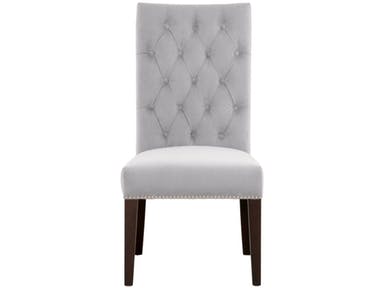
Sleek is the way to go: Orient Express Furniture Dining Room Uptown Dining Chair (Set of 2).
Small apartments, without a doubt, are one of the trickiest spaces to design. First of all, you have to deal with limited space and you also have to consider choosing which pieces to include in the design or not. A lot of homeowners have already made the mistake of designing their small apartments without rules and they end up crying over the disaster that strikes after.
Admit it, a smaller space has more requirements since you have limited real estate to beautify. Function and comfort are also two elements that you should not forget about.
Here are some mistakes that others before you have done. It’s time to learn from them –
As Flexible As Your Furniture
Most homeowners and even a few designers would say that huge furniture has no space in a small apartment. The mistake here, though, is that you are locked into thinking that you should only shop for smaller furniture pieces.
Having a successfully designed small space means you have to have furniture that is flexible. Learn to arrange furniture in the best possible way. You might consider investing in multiple pieces when you can actually just have one huge piece with more than one function.
Take for instance a daybed. This can serve as a sofa during the day and a bed at night. Nesting tables such as the Hooker Furniture Living Room Nesting Tables are also a good investment since the extra table can be pulled out the moment more guests arrive.
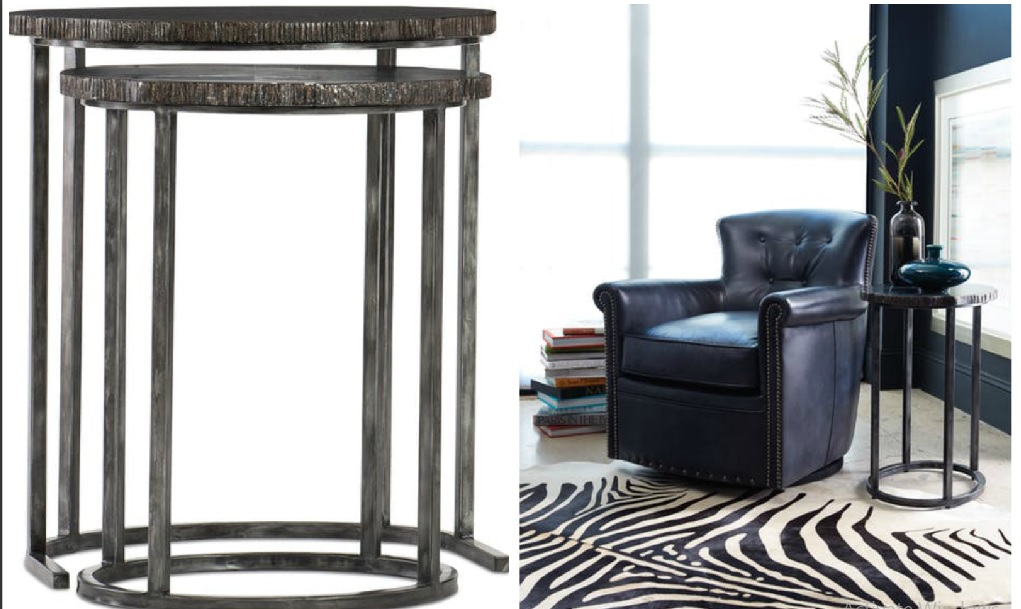
Hooker Furniture Living Room Nesting Tables
Correct furniture arrangement for a small apartment also means moving pieces out of the way before the guests arrive. You would want to keep furniture pieces that are mobile, simple, and versatile.
While it does make sense that you buy smaller furniture in a small apartment, the truth is, this isn’t a hundred-percent applicable at all times. Buying smaller pieces does not automatically make the apartment look bigger, in fact, if the proportions don’t make sense, then the apartment could end up looking smaller than it actually is. This is what’s known as the dollhouse effect.
Making Do with Limited Storage
Another huge mistake that many homeowners have made is to make do with the storage that they have in their small apartment. The smarter move is to figure out what you need to store. These are the things that you use daily or regularly.
Oprah Winfrey once said that if you’re no longer using something for six months or over, then, chances are, you won’t use that anymore.
Add storage if you have to but learn also to let go of stuff that only becomes clutter.
Not Following the 2/3 Rule
Whether you like it or not, you have to buy the proper size of furniture. Again, this is dependent on correct measurements. You don’t just eyeball a piece prior to purchasing it, you have to have the numbers to follow.
Not Trusting Your Gut Feel
As soon as you have made all the measurements and have purchased the furniture pieces, the next step is to plan how you can use each one in your home. While many design experts are more than willing to impart their know-how regarding this, your perception will always be the best tool that you can rely on. This is no less than your sixth sense so trust it when you are arranging the pieces that you have bought.
Always pay close attention to how you feel the moment you place the pieces in the living room, the bedroom or any room in your home. If it does not feel right, then more often than not, there is something wrong with the design that you just concocted.
Tags: designing a small apartment, McCreerys, McCreerys Home Furnishings, styling an apartment
Posted in Apartment Living, Condo Living, Interior Design 101, Interior Design Elements | Comments Off on Big Mistakes, Small Apartment
Monday, March 19th, 2018
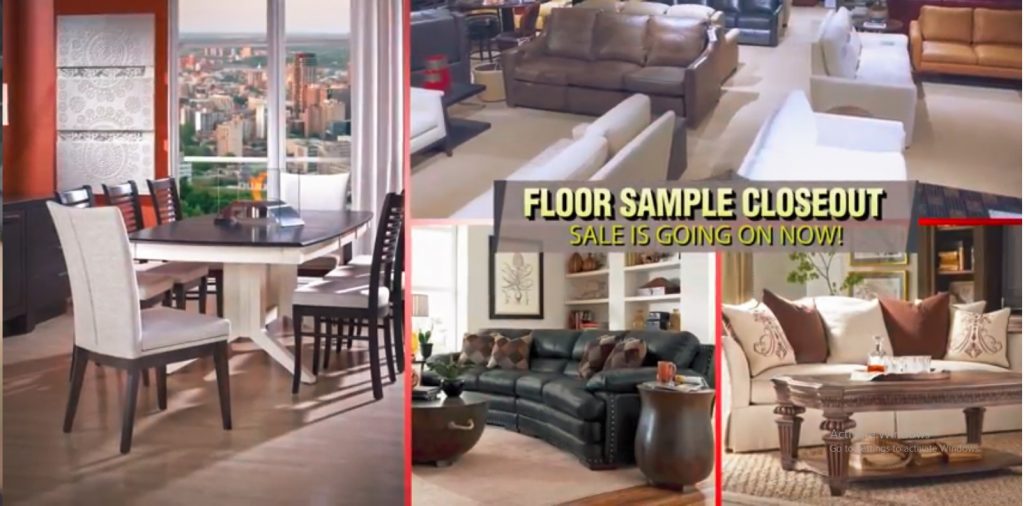 Many experts agree that one of the best months to find furniture deals is in July. Here at McCreery’s Furnishings, though, we give the best deals even when July’s still far, far away. Our virtual showroom is an awesome news for furniture buyers, such as yourself if you’re aching to find the hottest deals.
Many experts agree that one of the best months to find furniture deals is in July. Here at McCreery’s Furnishings, though, we give the best deals even when July’s still far, far away. Our virtual showroom is an awesome news for furniture buyers, such as yourself if you’re aching to find the hottest deals.
Finding the best living room set no longer requires that you and your family would drive to the furniture store two counties away. This is the beauty of technology because, now, you can buy right from the comfort of your bed with you in your pajamas.
We do understand that buying furniture is a sort of investment and that it really takes a huge leap of faith on the buyer’s part. Still, whichever way you look at it, there are bigger benefits of buying your furniture online.
First, you can scour for the best bargains on the internet. You score better with these discounts since you get the best-looking and most stylish ensemble at a discount. Just like our closeout sale for the month of March. Watch the video here – https://www.youtube.com/watch?v=3mdgul63fgo
Apart from huge discounts, another benefit is that you are not limited by your location. You can be miles away but you won’t have to worry about hauling bulky stuff to your home all on your own.
Now if you’re ready to shop, here are the basic guidelines to shopping for furniture on the Internet –
Be Sure to Measure
The very first thing that you have to be concerned about is scale. Use a blue painter’s tape to tape off the space where the furniture piece is supposed to be placed. For instance, if you’re investing in a recliner, be sure to mark off the dimensions including the extensions. Doing so will ascertain that the furniture will fit the space well.
Be Wary of the Lights
If you are bringing in a piece that’s tall and dramatic, then consider your current lighting system. You wouldn’t want your china cabinet damaging your prized chandelier as it is being delivered to your home. Once again, take the time to measure even the height of the room against the height of the incoming furniture piece.
Consider the Legs
If you’re not sure about a huge piece of furniture that might or might not overwhelm a room, then choose a model with legs rather than the one that has its base sitting on the floor. This also gives an airier look.
Check Out the Photos
One of the necessary steps in shopping online is to look at the posted photos. Color accuracy has already come a long way so view your options and then consider which one would agree with the theme that you have set in your home.
Don’t forget to compare, too. For instance, if you’re aiming at filling your bedroom with the necessary pieces, then scour for different bed photographs before you settle for the one that you truly like.
Always Think of Comfort
Online buying, of course, would not allow you to test the product in advance by sitting in it. Since this is the case, read the reviews about the furniture piece or, at the very least, the brand name in which the furniture comes.
Names such as Fine Furniture Design, Hooker Furniture, Bradington Young, Drexel Heritage, and Flexsteel are names that have weathered the tests of time. These are renowned brands that have brought many smiles to homeowners’ faces and have become a huge part of many stylish homes.
McCreery’s Home Furnishings proudly carries these famous brands which are the epitome of durability and beauty. Our name is also our guarantee in terms of comfort and style.
Tags: furniture online shopping, furniture shopping, McCreerys, McCreerys Home Furnishings, shopping for furniture online
Posted in 2018 Trends, Furniture, Interior Design 101, Interior Design Elements | Comments Off on McCreery’s Online Furniture Shopping – 5 Tips in Getting the Best Deals
© McCreery's Home Furnishings | All Rights Reserved | Privacy Policy